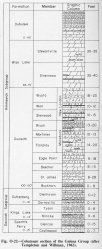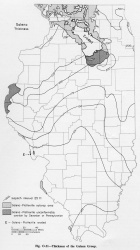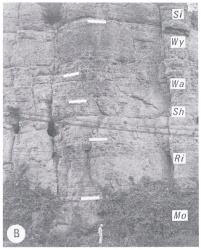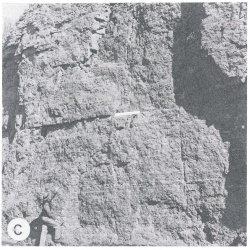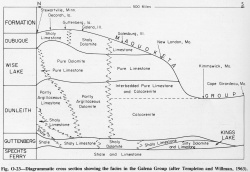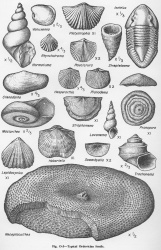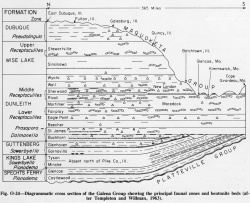Galena Group
Lithostratigraphy: Ottawa Limestone Megagroup >>Galena Group
Chronostratigraphy: Paleozoic Erathem >>Ordovician System >>Champlainian Series >>Trentonian Stage
Allostratigraphy: Tippecanoe Sequence
Primary source
Willman, H. B., Elwood Atherton, T. C. Buschbach, Charles Collinson, John C. Frye, M. E. Hopkins, Jerry A. Lineback, and Jack A. Simon, 1975, Handbook of Illinois Stratigraphy: Illinois State Geological Survey Bulletin 95, 261 p.
Contributing author(s)
H. B. Willman and T. C. Buschbach
Name
Original description
Galena Group (Hall, 1851, p. 146-148 ; Kay, 1935b, p. 289; Templeton and Willman, 1963, p. 93).
Derivation
The Galena Group is named for Galena in Jo Daviess County.
Other names
History/background
Type section
Type location
Several sections in the vicinity of Galena have been designated the type section of the Galena Group.
Type author(s)
Type status
Reference section
Reference location
Reference author(s)
Reference status
Stratigraphic relationships
The Galena Group consists of limestone and dolomite formations overlying the Platteville Group and underlying the Maquoketa Group of the Cincinnatian Series. Hall put the base of the Galena in the Decorah Subgroup, either at the top or the base of the Guttenberg Formation; Kay raised it to the top of the Decorah; and Templeton and Willman lowered it to the base of the Decorah, which is the present usage in Illinois. The group is divided into two subgroups (fig. O-22)- the Decorah at the base is a shaly unit and the Kimmswick above it is relatively pure limestone and dolomite. The shaly Dubuque Formation, although included as the top of the Galena Group in northwestern Illinois, is not included in the Kimmswick Subgroup.
Extent and thickness
The Galena Group is present in all of Illinois (fig. O-21) except (1) the areas where the older rocks are exposed in central northern Illinois and in Calhoun County and (2) an area along the crest of the La Salle Anticline, largely in La Salle County, where Galena strata were eroded before deposition of the Pennsylvanian rocks. The Galena is extensively exposed in northern Illinois (fig. O-2B, C), but elsewhere it crops out only in small areas on anticlinal structures in Calhoun, Monroe, and Alexander Counties. The Galena Group is 250-275 feet thick in the northern outcrop area, but the upper part is truncated by the Cincinnatian Series in central Illinois, and south of there the group is only 100-125 feet thick.
Lithology
The Galena Group has three major facies (fig. O-23). A fine-grained limestone facies is present only in extreme northwestern Illinois, where as much as 50 feet of limestone at the base of the group changes rapidly to dolomite southward and eastward. In most of northern Illinois, the group is entirely dolomite. Southward, the lower part becomes limestone, and a short distance south of La Salle only the uppermost part is dolomite. The lower part is largely coarse calcarenite, overlain by fine-grained limestone. Still farther south, the fine-grained limestone is truncated so that the group is entirely calcarenite and calcarenitic limestone.
Core(s)
Photograph(s)
Contacts
Well log characteristics
Fossils
Galena Group strata are generally fossiliferous (fig. O-5), but fossils are poorly preserved in the dolomite facies. Receptaculites oweni, an alga (fig. O-5), is perhaps the most characteristic fossil, but several zones characterized by abundance of certain species of brachiopods and bryozoans are persistent (fig. O-24).
Age and correlation
The Galena Group is equivalent to the Trenton Group of New York, the Lexington Limestone of Kentucky, and the Nashville Group of Tennessee.
Environments of deposition
Economic importance
“Kimmswick” and “Trenton” are informal names applied to producing zones in the Galena Group.
Remarks
References
HALL, JAMES, 1851, Lower Silurian System: Upper Silurian and Devonian Series, in Report on the geology of the Lake Superior land district, Part 2: U.S. 32nd Congress Special Session, Senate Executive Document 4, p. 140-166; American Journal of Science, v. 17, p. 181-194.
KAY, MARSHALL, 1935b, Ordovician System in the Upper Mississippi Valley: Kansas Geological Society Guidebook, 9th Annual Field Conference, p. 281-295.
TEMPLETON, J. S., and H. B. WILLMAN, 1963, Champlainian Series (Middle Ordovician) in Illinois: Illinois State Geological Survey Bulletin 89, 260 p.
ISGS Codes
| Stratigraphic Code | Geo Unit Designation |
|---|---|
